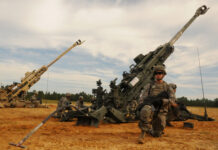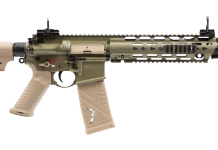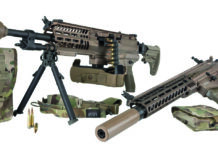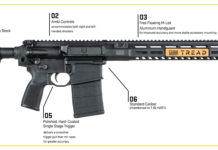These days it is no surprise to see an assault rifle festooned with all sorts of accessories, all accommodated on rail systems attached to the body of the weapon. There appear to be no limits as to what users wish to attach to weapons, almost to the point where the original assault rifle appears to be totally unbalanced due to all the bits and pieces that some users feel are absolutely essential to conduct their mission. Certainly Special Operations Forces (SOF) seem to be particularly keen on maximising the accessory count on their weapons.
The roads to personal weapons having the ability to accept a profusion of different sights, accessories and ancillary systems has been a long one. There are a multitude of reasons for this, some are technical, a lot of the technologies that are commonplace today were, exotic and expensive, and in many cases not that impressive, or simply did not exist in the 1970s for example.
Then innate conservatism comes into play, the infantry have been using rifles with iron sights virtually forever, teaching marksmanship is a fundamental part of the training regime and obviously gets results. Spending money on optical sighting systems for ordinary infantry might be considered unnecessary, and as an expensive and pointless luxury when existing methods are perfectly satisfactory. Again if we use the 1970s as our starting point the quality versus cost argument did not appear to be that persuasive in terms of an optic for an individual rifle.
On the other hand, there were no objections to fitting telescopic sights to sniper rifles, people had been doing this for more than a century! Obviously in that period the quality of optical sights increased significantly. Today, there is a vast choice of sniper rifles, and these come in a multiplicity of calibres. In parallel there is a large selection of precision optics that can be utilised by these sniper rifles offering high precision anti-personnel/anti-materiel capabilities at extraordinary ranges, compared to previous sniping capabilities. The asymmetric conflicts in Iraq and Afghanistan proved conclusively that possession of a high quality sniping capability is essential on the modern battlefield. Ideally having the ability to acquire different rifle solutions, usually in different calibres, for anti-materiel and anti-personnel applications.

Credit: French Army
Early Solutions
In the past though the picture as regards sniping was far less indulgent, sniping was acknowledged as having real value, but weapons that were specifically designed for sniping applications were simply not considered as necessary. The British Army provides an excellent example of how sniping and the provision of equipment for sniping has changed over the years. The starting point for this is with the Lee Enfield bolt action battle rifle in 7.7×56 mmR (.303) calibre, this was manufactured in Britain from 1895 until 1956. Like many others, the British Army would base its sniper rifle on the in-service rifle.
When the No.4 Mk.1 Lee Enfield was the standard production rifle, the most accurate rifles were identified during the production process and put to one side for conversion to a sniper rifle. This saw changes to the wooden rifle furniture to the sniper configuration and attachment points were added to mount the No.32 3.5× telescopic sight, with the weapon designated as the No.4 Mk.1 (T). This was followed by the No.4 Mk.1* (T), with the No.32 sight undergoing various improvements as well. These 7.7×56 mmR sniper rifles remained in service to the end of the 1960s.
By this point, the 7.62×51 mm NATO round had been the standard round in the British Army for some 15 years and it was decided to develop a sniper system that used this calibre. The solution selected was to convert some 1,000 No.4 Mk.1 (T) and No.4 Mk.1* (T) to the 7.62×51 mm calibre with a new free-floating barrel, change the wooden furniture to accommodate the new barrel and refurbish the No.32 telescopic sight. The end result was the L42A1 rifle which served for nearly 20 years.
It was the competition to replace L42A1 that would mark the transition of sniper rifles to the specialised high performance systems that they are today. A small British company, which has a fascinating history, called Accuracy International (AI) had been established as a small-scale precision rifle manufacturer for civilian competition shooting. AI had developed a rifle called the Precision Marksman (PM), British Special Forces, in the form of the Special Boat Service (SBS), evaluated the PM in 1984 and decided to buy eight in 1985. Then the Special Air Service (SAS) decided to purchase 32 rifles in the same year.
The Revolution Commences
AI had entered the military market and its Special Forces customers provided feedback on improvements into the design. Then an unexpected opportunity emerged, the British Army was looking for a new 7.62×51 mm sniper rifle to replace the L42A1 and AI decided to enter a developed version of the PM into the trials for the new sniper rifle. The competitors were Heckler & Koch (HK), Remington, Parker Hale and SIG Sauer. It appears that AI entered the trials not expecting to win, they wanted to see what military trials were like and what lessons they could learn for future developments.
The rifle AI entered into the trials was unique, it was modular and based on a chassis system and used non-traditional materials. It was also extremely accurate; the effective range of the L42A1 was 600 m and it could provide harassing fire out to 800 m, the AI rifle had an effective range of 900 m and could deliver harassing fire out to 1,100 m. AI won the competition and in March 1985 were awarded a contract for 1,212 rifles, designated as the L96A1, with first deliveries in 1987.
The L96A1 in conjunction with its Schmidt & Bender PM 6×42 telescopic sight, known as the L13A1, delivered a revolution in British sniping. Apparently one unanticipated side effect was that more people were passing the sniper course with the L96A1, than with the L42A1. Others took notice of the L96A1, with the Swedish Army approaching AI for a new sniper rifle, based on the L96A1, that was optimised for their operational environment, and this resulted in the Arctic Warfare (AW) sniper rifle, again in 7.62×51 mm. In 1991, Sweden ordered 1,100 AW rifles from AI.
The AW was widely sold internationally and was also adopted by British Special Forces, being used for a number of applications including the Counter-Terrorism Sniper Rifle (CTSR), with the rifle being given the L118A1 and the L118A2 designator. The L118A2 differs by having a folding stock. This is a 7.62×51 mm weapon and is equipped with a Schmidt & Bender 3-12×50 L17A1 telescopic sight mounted on a MIL-STD-1913 (Picatinny) rail. Another Picatinny rail can be mounted on the front block, and this will accommodate the Sniper Thermal Image Capability (STIC) from Qioptic, this places the thermal imager in front of the main sight thus providing a thermal capability. Alternatively, there is a mounting point over the sight for a Simrad image intensifier, this can then be placed in front of the main sight to give an image intensification capability.
New Calibres Emerge
The Schmidt & Bender L17A1 sight and the STIC system are also used on another AI product in service with the British military, the L121A1 precision anti-materiel rifle in 12.7×99 mm NATO (.50 BMG). This is also known as the AW50 rifle. The L17A1 sight was also integrated with the L96A1, replacing the earlier L13A1 sight, as part of an upgrade programme. AI were also developing their weapons to accommodate new rounds, working with Lapua for .338 Lapua Magnum (8.6×70 mm), and utilising the .300 Winchester Magnum (7.62×67 mmB).
AI rifles in .300 Winchester Magnum were acquired by the German military as the G22 and featured a Hensoldt 3-12×56 scope, the next iteration was the G22A1 and this featured a Schmidt and Bender 3-12×50 scope. The G22/G22A1 were then upgraded to the current G22A2 configuration, and this has a Steiner-Optik M5Xi 5-25×56 scope. The German military operate other AI rifles in 12.7×99 mm NATO and 7.62×51 mm NATO calibres.
At the end of the 1990s British Special Forces adopted the AI AWM rifle in .338 Lapua Magnum as the L115A1 with the Schmidt & Bender 3-12×50 mm PM II scope. The L115A2 model had a folding stock and a new bipod, with many L115A1s upgraded to the new configuration. The British Army then entered the fray with a requirement known as the Sniper System Improvement Programme (SSIP). The SSIP was about more than acquiring a new sniper rifle, it also included image intensification and thermal capabilities, laser rangefinders and spotting scopes.

Credit: Crown Copyright
In 2007 AI were awarded a contract for 582 L115A3 rifles, with first deliveries in April 2008 to replace the L96A1. The weapon has a Schmidt & Bender 5-25×56 scope and like the earlier L118A1 this scope can be integrated with thermal or image intensification systems. The rifle can be equipped with a suppressor, interestingly French sniper rifle manufacturer PGM Precision offer a suppressor for their own rifles and also for AI rifles in Lapua or Winchester Magnum. The reason that the SSIP went for a .338 Lapua Magnum rifle was the need to be able to engage targets at extended ranges, out to beyond 2,000 m. One British Army L115A3 sniper in Afghanistan neutralised a target at 2,475 m.
British Army snipers operate in two-person teams, the sniper and the spotter, with the spotter being equipped with the Sniper Support Weapon (SSW). The SSW is a variant of the LM Defense LW308 Modular Weapon System (MWS) adopted by the British Army as the L129A1 designated marksman weapon. This is a semi-automatic 7.62×51 mm system, with a 6×48 Trijicon ACOG sight. The SSW variant mounts a Schmidt & Bender L17A2 3-12×50 scope and utilises a suppressor from Surefire in the US. Should the L115A3 sight be damaged, the SSW L17A2 scope would be attached to the sniper rifle and the SSW would revert to iron sights.
Other sniping developments that should be taken into account include a number of issues related to the telescopic sight to reduce its signature ranging from a lens hood to the integration of an anti-reflection KillFlash system on the sight. Also the sight would be fitted with laser filters to protect against lasers on the battlefield. Also worthy of note is ongoing British investment in sniping capabilities; Greek company Theon Sensors, in association with British partner Active Electronics, was contracted to supply an initial quantity of 500 Thermis CS thermal imaging systems for the Sniper In-Line Low Light System (SILLS) – Long Wave InfraRed (LWIR) Thermal Sight “Weapon Sight 2” programme. Previously the company had supplied clip-on night vision and thermal solutions for a Canadian Forces sniper programme.
In a more weapon related context, British Special Forces wanted to get even more range out of the L115 and took to using a heavier 300 grain .338 Lapua Magnum round, as this was longer than the standard round they loaded these rounds singly. Later the new L115A4 variant was fielded, this had a new magazine and magazine well to handle the 300 grain round. There was an intention to upgrade existing L115A3 weapons to the L115A4 standard, this idea appears to have fallen by the wayside and only Special Forces have the L115A4.
Capability Cascades
Technology has transformed the capabilities of the modern sniper rifle, it is well to remember that in 1970 that the British Army was content to refurbish a sniper rifle and telescopic sight from the 1940s, convert it to 7.62×51 mm and that was considered perfectly acceptable to remain in frontline service until the end of the 1980s. Equally it was considered as perfectly acceptable for the ordinary infantry soldier whether equipped with a 7.62×51 mm battle rifle or a 5.56×45 mm assault rifle to just rely on iron sights. Change was on the way though, and just as with sniper rifles, the infantry rifle would embark on its own evolutionary voyage. The starting point would be Austria adopting the Sturmgewehr 77 (Steyr AUG) with its integrated Swarowski 1.5× optic. Then came Britain with the L85 5.56×45 mm assault rifle and the L9A1 Sight Unit Small Arms Trilux (SUSAT), a 4× optic.
Weapon optics manufacturers that can be said to have made a major contribution to the small arms optics area are Raytheon Elcan, Aimpoint and Trijicon. When Canada adopted the C7/C8 5.56×45 assault rifle family, Raytheon Elcan were tasked with the development of an optic for these weapons resulting in the Specter OS (known as the C79 to the Canadian Forces) which arrived at the end of the 1980s. Since then the family of Specter optics has evolved and the company would go on to sell more than 475,000 Specter systems. This total has since grown, due to the fact that at the end of 2021 Raytheon Elcan and Leonardo Germany won the Germany Army HKV Main Combat Sight programme for 107,929 optics based on the Specter DR 1-4× system.

Credit: Australian DoD
Aimpoint has been providing their Comp series for over 20 years, in July 2018 they won a contract to supply the French military with 120,000 CompM5 optics for integration with the HK416F assault rifle over the six years following the contract announcement. In April this year, Aimpoint was awarded a seven-year framework contract for the British Support Weapons Enhanced Sighting Systems (SWESS) programme. The SWESS – Light Battlesight Project covers 5.56 mm and 7.62 mm machine guns with the CompM4 sight combined with ballistic adjustable mounts and 3× magnifiers. The other SWESS element covers heavier support weapons such as Carl Gustaf M4, 40 mm AGL and 12.7×99 mm heavy machine gun.
Trijicon had developed the TA01 4×32 Advanced Combat Optical Gunsight (ACOG) in 1987 and this was rapidly adopted by US Special Forces and foreign customers. The ACOG also provided the basis for the US Marine Corps Rifle Combat Optic (RCO), while the Trijicon Variable Combat Optic Gunsight (VCOG), a 1-8×28 optic, was selected as the Squad Common Optic (SCO), the successor to the RCO. In excess of one million ACOG have been sold.
The US Marine Corps also seems to be leading the way in terms of adopting a suppressor for the majority of its small arms. They have conducted extensive suppressor field trials over a number of years and in 2020 acquired 6,700 systems, followed by a further buy of 7,000 systems. An additional 30,000 systems will enter service this year, being used by M4/M4A1 carbines, the M27 Infantry Automatic Rifle (IAR) and the M38 Designated Marksman Rifle, a version of the M27.
In the final analysis, fit a rifle with Picatinny, M-LOK or any other viable modern rail system and you can attach all sorts of sights and other devices, depending on mission requirement and/or budget. However, others might find the future US Army XM5 rifle, replacing the M4/M4A1, and the XM250 automatic rifle, replacing the M249 SAW, being built by SIG Sauer, as the optimum solution, with most of the required capabilities already installed!

Credit: USMC
Using the 6.8×51 mm Common Cartridge Family, the weapons are fitted with a SIG Sauer SLX suppressor and the Vortex Optics XM157 fire control system (FCS). The US Army states that: “The XM157 integrates a number of advanced technologies, including a variable magnification optic (1X8), backup etched reticle, laser rangefinder, ballistic calculator, atmospheric sensor suite, compass, Intra-Soldier Wireless, visible and infrared aiming lasers, and a digital display overlay.”
There are other possibilities though, Future Soldier Systems offer the potential to integrate the soldier and the weapon with a complete range of fire control and sensor systems, with sensors mounted on and separate to the soldier. Therefore the future of infantry weapons and sights would seem to offer a whole range of avenues to explore.
David Saw






